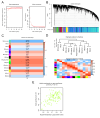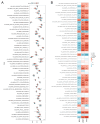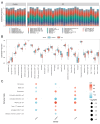Bioinformatics identifies key genes and potential therapeutic targets in the pathological mechanism of oxidative stress in Randall's plaque
- PMID: 39732836
- PMCID: PMC11682209
- DOI: 10.1038/s41598-024-82849-y
Bioinformatics identifies key genes and potential therapeutic targets in the pathological mechanism of oxidative stress in Randall's plaque
Abstract
Randall's plaque (RP) is recognized as a precursor lesion for kidney stones, with its formation and progression potentially linked to oxidative stress. Previous studies have provided limited insights into the underlying mechanisms of RP, failing to fully elucidate its molecular pathways. To investigate the relationship between oxidative stress and RP, we employed bioinformatics approaches to identify key genes, predict associated pathways and drug molecules, analyze variations in immune cell populations, and construct diagnostic models. We initially identified three differentially expressed genes related to oxidative stress: BFSP1, LONF1, and TAF1D. These genes and their co-expressed counterparts are enriched in pathways related to oxidative phosphorylation, cellular adhesion processes, steroid hormone biosynthesis, and autophagy. Furthermore, we observed significant differences in two types of immune cells across the study groups. Ultimately, predictions from drug molecular docking suggest that BFSP1 may serve as a promising therapeutic target for RP. We propose that the formation of RP mediated by oxidative stress could be associated with BFSP1, LONF1, TAF1D along with CD56dim natural killer cells and memory B cells. Thus far, BFSP1 emerges as a pivotal therapeutic target for RP development. These findings offer new perspectives on the mechanisms underlying the pathogenesis of RP.
Keywords: BFSP1; Bioinformatic analysis; LONRF1; Oxidative stress; Randall's plaque; TAF1D.
© 2024. The Author(s).
Conflict of interest statement
Declarations. Competing interests: The authors declare no competing interests.
Figures










Similar articles
-
Collagen fibrils and cell nuclei are entrapped within Randall's plaques but not in CaOx matrix overgrowth: A microscopic inquiry into Randall's plaque stone pathogenesis.Anat Rec (Hoboken). 2022 Jul;305(7):1701-1711. doi: 10.1002/ar.24837. Epub 2021 Nov 30. Anat Rec (Hoboken). 2022. PMID: 34825513 Free PMC article.
-
Identification of the core genes in Randall's plaque of kidney stone and immune infiltration with WGCNA network.Front Genet. 2023 Feb 1;14:1048919. doi: 10.3389/fgene.2023.1048919. eCollection 2023. Front Genet. 2023. PMID: 36816033 Free PMC article.
-
Helper T-cell signaling and inflammatory pathway lead to formation of calcium phosphate but not calcium oxalate stones on Randall's plaques.Int J Urol. 2019 Jun;26(6):670-677. doi: 10.1111/iju.13950. Epub 2019 Mar 28. Int J Urol. 2019. PMID: 30919502
-
Beginnings of nephrolithiasis: insights into the past, present and future of Randall's plaque formation research.Curr Opin Nephrol Hypertens. 2018 Jul;27(4):236-242. doi: 10.1097/MNH.0000000000000414. Curr Opin Nephrol Hypertens. 2018. PMID: 29697409 Review.
-
Randall's plaque and calcium oxalate stone formation: role for immunity and inflammation.Nat Rev Nephrol. 2021 Jun;17(6):417-433. doi: 10.1038/s41581-020-00392-1. Epub 2021 Jan 29. Nat Rev Nephrol. 2021. PMID: 33514941 Review.
References
-
- Sorokin, I. et al. Epidemiology of stone disease across the world. World J. Urol.35, 1301–1320 (2017). - PubMed
MeSH terms
LinkOut - more resources
Full Text Sources

